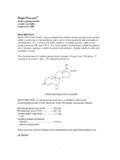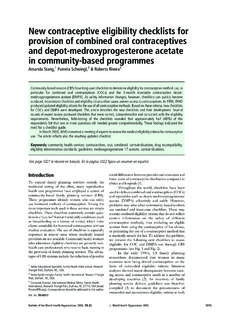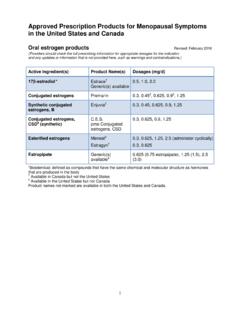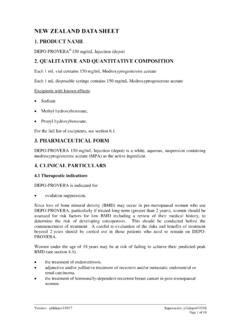Transcription of PROVERA Medroxyprogesterone acetate - Medsafe
1 DATA SHEET PROVERA Medroxyprogesterone acetate mg, 5 mg, 10 mg, 100 mg and 200 mg tablets PRESENTATION PROVERA tablets contain Medroxyprogesterone acetate (MPA) as the active ingredient. PROVERA mg tablets are orange, circular, scored one side, marked U64 on the other. PROVERA 5 mg tablets are blue, circular, scored one side and marked 286 on both sides of the score line, marked U on the other. PROVERA 10 mg tablets are white, circular, scored marked UPJOHN 50. PROVERA 100 mg tablets are white, scored, marked U467. PROVERA 200 mg tablets are white, scored, marked U320. USES Actions Animal MPA induces responses in laboratory animals comparable to those caused by progesterone. It is more potent than progesterone. MPA induces glandular maturation in the endometrium, maintains pregnancy, delays parturition, inhibits ovulation and suppresses estrous cycles.
2 It is devoid of androgenic and estrogenic activity. In selected animal tests it has some adrenal cortico id-like activity and in dogs increases serum growth hormone levels. Human MPA is a progestational agent. When administered in recommended doses to women with adequate endogenous estrogen, it transforms proliferative into secretory endometrium. MPA may inhibit gonadotrophin production, which in turn prevents follicular maturation and ovulation. Similar to progesterone, MPA is thermogenic. At the very high dosage levels used in the treatment of certain cancers (500 mg daily or more), cortico id-like activity may be manifest. Pharmacokinetics PROVERA is an orally active progestational steroid having an apparent half-life of about 30 hours. MPA is rapidly absorbed after oral administration.
3 There is high inter-individual variabilit y in serum levels after standard doses given by either route of administration. Version: pfdprovt11016 Supersedes: pfdprovt10816 Page 1 of 12 MPA is metabolised and conjugated in the liver. Metabolic products are predominantly excreted in the urine both as conjugated and free forms. INDICATIONS PROVERA mg, 5 mg and 10 mg tablets are indicated for: diagnosis of primary and secondary amenorrhoea treatment of dysfunctional (anovulatory) uterine bleeding opposit ion o f endo metrial effects of estrogen in menopausal women being treated with estrogen (hormone replacement therapy [HRT]) treatment of endometriosis. PROVERA 100 mg and 200 mg tablets are indicated as adjunctive and/or palliative treatment of recurrent and/or metastatic endometrial or renal carcinoma and, in the treatment of hormonally-dependent, recurrent breast cancer in post-menopausal women.
4 DOSAGE AND ADMINISTRAT I ON Use of combined estrogen/progestogen therapy in postmenopausal women should be limited to the lowest effective dose and the shortest duration consistent with treatment goals and risks for the individual woman, and should be periodically evaluated (see WARNINGS AND PRECAUTIONS). Unless there is a previous diagnosis of endometriosis, it is not recommended to add a progestogen in a woman without an intact uterus. Diagnosis of primary and secondary amenorrhoea mg to 10 mg per day for 5 to 10 days. Dysfunctional (anovulatory) uterine bleeding mg to 10 mg per day for 5 to 10 days for 2 to 3 cycles and then discontinued to see if the dysfunction has regressed. If bleeding occurs from a poorly proliferative endometrium, estrogens should be used concomitantly with PROVERA therapy.
5 Opposition of endometrial effects of estrogen in menopausal women being treated with estrogen For women taking mg of conjugated estrogen or an equivalent daily dose of another estrogen, PROVERA can be given in 1 or 2 regimens: Continuous regimen of mg to mg daily. Sequential regimen of 5 mg to 10 mg daily for 10 to 14 consecutive days of a 28-day or monthly cycle. Version: pfdprovt11016 Supersedes: pfdprovt10816 Page 2 of 12 Endometriosis 10 mg 3- times a day for 90 consecutive days, beginning on the first day of the menstrual cycle. Endometrial and renal carcinoma 100 mg to 600 mg per day is recommended. Breast cancer 400 mg to 1500 mg per day is recommended. The patient should then be continued on therapy as long as she is responding to treatment. NOTE: Response to hormonal therapy for endometrial, renal or breast cancer may not be evident until after 8 to 10 weeks of therapy.
6 In the event of a rapid progression of disease at any time during therapy, treatment with PROVERA should be terminated. PROVERA is not recommended as primary therapy, but as adjunctive and palliative treatment in advanced, inoperable cases including those with recurrent or metastatic disease. CONTRAINDICATIONS PROVERA is contraindicated in patients with: thrombophlebitis, thrombotic or thromboembolic disorders, cerebral apoplexy or patients with a past history of these conditions markedly impaired liver function undiagnosed vaginal bleeding undiagnosed urinary tract bleeding undiagnosed breast pathology missed abortion known sensitivity to MPA or to any of the excipients in the tablet (see FURTHER INFORMATION, Excipients) known or suspected pregnancy (see WARNINGS AND PRECAUTIONS, Precautions, Use in pregnancy and Use in lactation) severe uncontrolled hypertension known or suspected malignancy of the breast (excluding use in oncology indications).
7 WARNINGS AND PRECAUTIONS Warnings The physician should be alert to the earliest manifestations of thrombotic disorders (thrombophlebitis, cerebrovascular disorders, pulmonary embolism, and retinal thrombosis). Should any of these occur, the drug should be discontinued immediately. Discontinue medication pending examination if there is sudden partial or complete loss of vision, or if there is a sudden onset of proptosis, diplopia or migraine. If examination reveals papilloedema, or retinal vascular lesions, medication should be withdrawn. Version: pfdprovt11016 Supersedes: pfdprovt10816 Page 3 of 12 Clinical suppression of adrenocorticoid function has not been observed at low dose levels, however, at the high doses used in the treatment of cancer, corticoid-like activity has been reported.
8 MPA may decrease adrenocorticotrophic hormone and hydrocortisone blood levels. Animal studies show that Medroxyprogesterone possesses adrenocorticoid activity. The following laboratory tests may be affected by the use of PROVERA : gonadotrophin levels plasma progesterone levels urinary pregnanediol levels plasma testosterone levels (in the male) plasma estrogen levels (in the female) sex-hormone-binding globulin plasma cortiso l levels glucose tolerance test metyrapone test - the use of MPA in oncology indications may cause partial adrenal insufficiency (decrease in pituitary-adrenal axis response) during metyrapone testing. Thus, the ability of the adrenal cortex to respond to adrenocorticotrophic hormone should be demonstrated before metyrapone is administered. Observational and randomised, prospective trials on the long-term effects of a combined estrogen/progestogen regimen in postmenopausal women have reported an increased risk of several disorders including cardiovascular diseases ( , coronary heart disease and stroke), breast cancer, and venous thromboembolism.
9 Mortality can be increased in those who are diagnosed with incident breast cancers. The possible effect of HRT on mammographic density and on the sensitivity and specificity of breast cancer screening should also be considered. Combination HRT should not be used in hysterectomised women because it is not needed to prevent endometrial changes in these women and it may increase the risk of breast cancer. Ovarian cancer Ovarian cancer is much rarer than breast cancer. Epidemiological evidence from a large meta-analysis suggests a slightly increased risk in women taking estrogen-only or combined estrogen-progestogen HRT, which becomes apparent within 5 years of use and diminishes over time after stopping. Some other studies, including the Wo men s Healt h Initiative trial, suggest that the long-term use of combined HRTs may be associated with a similar or slightly smaller risk (see ADVERSE EFFECTS).
10 The benefits and risks of HRT must always be carefully weighed, including consideration of the emergence of risks as therapy continues. Use of combined estrogen/progestogen therapy in postmenopausal women should be prescribed at the lowest effective doses and limited to the shortest duration consistent with treatment goals and risks for the individual women, and should be periodically evaluated. HRT in postmenopausal women is not generally appropriate for long term use and should not be prescribed for longer than 6 months wit hout re-examining the patient. Decrease in bone mineral density There are no studies on the bone mineral density (BMD) effects of PROVERA . Version: pfdprovt11016 Supersedes: pfdprovt10816 Page 4 of 12 Use of Depo- PROVERA (DMPA) injection reduces serum estrogen levels in premenopausal women and is associated with a statistically significant loss of BMD as bone metabolism accommodates to a lower estrogen level.















